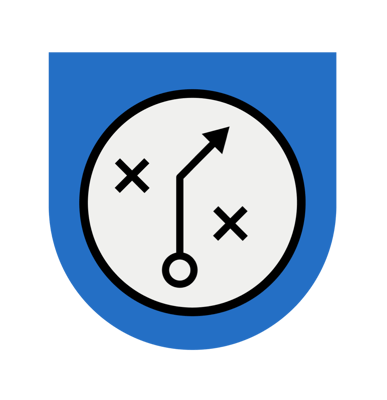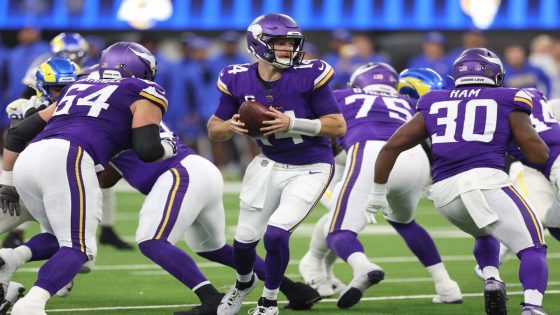In August, offensive coordinator Wes Phillips outlined the Minnesota Vikings’ vision. They wanted to take better care of the football. They wanted to run more effectively. With the addition of running back Aaron Jones and physicality being a focal point, the coaching staff felt it could be the franchise’s most well-rounded unit in years.
“We’ve got good players,” Phillips said then, “and if we do the little things right, we won’t have to have the perfect play called all the time.”
The Vikings have taken better care of the football through seven games, but the bar was low. At this time last year, Minnesota had turned the ball over 14 times. This year, that number is 10. The run game has improved — but not drastically. The Vikings averaged 4.0 yards per carry in 2023. This year, they’re averaging 4.2.
While Minnesota’s passing game mirrors last year’s in many ways — it remains one of the most efficient and explosive in the NFL — there are still plenty of mistakes. This year, the “little things” dooming the Vikings offense are penalties and sacks. Only four NFL offenses have committed more penalties, and only four have taken more sacks.
If you have watched the games, you know that the Vikings offense glides through defenses in the first quarter, then often looks stuck in the mud in the second. That dichotomy captures what the offense can be, but also how often it falls short. Boom or bust. Feast or famine. Capable of looking like a force to be reckoned with, but also sporadic enough to hand momentum away to a lesser opponent.
Minnesota’s offense is caught between these two worlds, so it hovers in the middle in almost every meaningful metric. Offensive success rate? The Vikings rank 15th. EPA per play? The Vikings rank 18th. They’re 14th in points per drive, 16th in offensive DVOA (which accounts for strength of schedule) and 11th in yards per play. None of these metrics would categorize the offense as either elite or terrible, which is why the unit’s performance often feels so close to where the coaches want it to be.
“We’ve got to continue to find ways to just consistently get all 11 guys on the offense doing their jobs,” head coach Kevin O’Connell said Thursday night following the Vikings’ loss to the Los Angeles Rams. “That’s out of the huddle, how we articulate the plays, how we break the huddle with a total command of the system.”
Four of those 11 have been consistent and reliable: superstar wide receiver Justin Jefferson, running back Aaron Jones, right tackle Brian O’Neill and left tackle Christian Darrisaw. With the torn ACL and MCL Darrisaw suffered late in the second quarter in L.A., that number has dwindled to three.
Coach O’Connell gives update on Christian Darrisaw pic.twitter.com/UlAACSXYYw
— Minnesota Vikings (@Vikings) October 25, 2024
Jefferson’s presence provides a one-man explosive play rate. Only four non-quarterbacks have more plays of 10 or more yards than he does this season. Jones single-handedly has lifted the ceiling for the Vikings’ rushing attack. Without him, the only worse rushing team in the league is the Raiders. Together, these two players have more plays of 10-plus yards than the rest of the Minnesota offense combined.
Darrisaw and O’Neill, meanwhile, stabilized the infrastructure that allowed Jefferson and Jones to impress. Now, one-half of that structure requires triage. Less of a push on the left side of the line in run blocking could hinder what has been a synchronized rushing attack. The Vikings have an almost equal number of rushing attempts toward the right and left. Being more predictable might mean a more limited menu, which certainly won’t help.
No team in the NFL is more efficient than the Vikings when they need 5 yards or fewer on second down. So, if Jones cannot get the Vikings into these balanced situations, more of a burden will fall on O’Connell as the play caller and quarterback Sam Darnold.
Darrisaw’s absence matters here, too. In obvious passing situations, Minnesota has mostly provided extra blocking help (in the form of fullback C.J. Ham) on the interior. Shifting the assistance to the edge could make the interior more susceptible to the pass rush. And although pressure has not ruined Darnold (he only has one interception this season when pressured, according to Pro Football Focus), his completion percentage falls nearly 20 percent when he’s pressured. Pressure applied on him also turns into sacks at a rate higher than all but Baker Mayfield, Deshaun Watson and Caleb Williams.
All of this points to an obvious conclusion: Losing Darrisaw will make it harder for a Vikings offense that has already had trouble sustaining drives. This could mean more time on the field for a veteran-laden defense that has already spent a significant amount of time on the field. It’s also why, as of last Friday, the Vikings refrained from quickly identifying a replacement at left tackle.
“I do think there are multiple options on the table with that,” O’Connell said last week, “and that’s what we’ve got to figure out.”
If the Vikings go with an internal replacement, veteran tackle David Quessenberry is an option. He has started 23 games in his eight-year career. Minnesota could also shift Blake Brandel from left guard to left tackle and plug the left guard hole with Dalton Risner. Brandel has started five games at tackle in his career.
If the Vikings look externally, the Jaguars’ Cam Robinson, the Browns’ Jedrick Wills and the Titans’ Daniel Brunskill could be rental options before next week’s trade deadline.
As the Vikings navigate their decision and sort through how Darrisaw’s absence will affect the offense, two factors are in Minnesota’s favor. The first is the return of tight end T.J. Hockenson, who should offer a quick outlet for Darnold. The second is the Vikings’ schedule — specifically the next two opponents (Indianapolis and Jacksonville), both of whom have defenses ranking in the bottom half of the NFL.
On paper, this stretch should allow the Vikings offense to do what it does best: complete passes through, around and over the top of the opposition. As long as Minnesota has the time to do that, their Jenga tower — which has not been the tallest or most impressive to this point — should stay mostly intact.

Free, daily NFL updates direct to your inbox.
Free, daily NFL updates direct to your inbox.
Sign Up
(Photo of Sam Darnold: Harry How / Getty Images)





